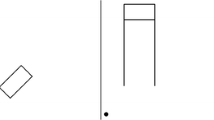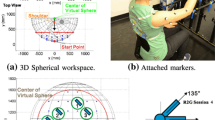Abstract
There is a movement preparation cost for bimanual asymmetric reaching movements compared to bimanual symmetric movements. This is likely caused by the complex spatiotemporal coupling of bimanual asymmetric movements. The spatiotemporal coupling of bimanual reach-to-grasp movements has been investigated, but not the potential movement preparation costs. The purpose of the present study was to investigate the relationship between movement preparation costs and spatiotemporal coupling of reach-to-grasp movements. Twenty-four participants made unimanual, bimanual symmetric, and bimanual asymmetric reach-to-grasp movements in four-choice reaction time tasks. There was a movement preparation cost for bimanual symmetric reach-to-grasp movements compared to unimanual movements, which was not previously seen for reaching movements. Coordinating two symmetric grasps probably caused this bimanual symmetric cost, as we have previously shown that there is no bimanual symmetric cost for reaching movements. It was also surprising that the complexity of movement preparation was comparable for bimanual symmetric and asymmetric reach-to-grasp movements. However, the spatial coupling of bimanual asymmetric movements at movement initiation suggested that they were prepared as bimanual symmetric movements. Online control was then used to modify these symmetric reach-to-grasp movements into asymmetric movements. Preparing bimanual symmetric reach-to-grasp movements in advance instead of asymmetric movements likely prevented a bimanual asymmetric cost.







Similar content being viewed by others
References
Bingham GP, Hughes K, Mon-Williams M (2008) The coordination patterns observed when two hands reach-to-grasp separate objects. Exp Brain Res 184(3):283–293
Blinch J, Cameron BD, Cressman EK, Franks IM, Carpenter MG, Romeo R (2014) Comparing movement preparation of unimanual, bimanual symmetric, and bimanual asymmetric movements. Exp Brain Res 232(3):947–955
Brown SG, Roy EA, Rohr LE, Bryden PJ (2006) Using hand performance measures to predict handedness. Laterality 11(1):1–14
Castiello U, Bennett KMB, Stelmach GE (1993) The bilateral reach to grasp movement. Behav Brain Res 56(1):43–57
Cavina-Pratesi C, Monaco S, Fattori P, Galletti C, McAdam TD, Quinlan DJ, Goodale MA, Culham JC (2010) Functional magnetic resonance imaging reveals the neural substrates of arm transport and grip formation in reach-to-grasp actions in humans. J Neurosci 30(31):10306–10323
Cavina-Pratesi C, Connolly JD, Monaco S, Figley TD, Milner AD, Schenk T, Culham JC (2018) Human neuroimaging reveals the subcomponents of grasping, reaching and pointing actions. Cortex 98:128–148
Cousineau D (2005) Confidence intervals in within-subject designs: a simpler solution to Loftus and Masson’s method. Quant Meth Psych 1(1):42–45
Dohle C, Ostermann G, Hefter H, Freund HJ (2000) Different coupling for the reach and grasp components in bimanual prehension movements. Neuroreport 11(17):3787–3791
Donders FC (1969) On the speed of mental processes. Acta Psychol 30:412–431
Fitts PM, Peterson JR (1964) Information capacity of discrete motor responses. J Exp Psychol 67(2):103–112
Gallivan JP, McLean DA, Valyear KF, Pettypiece CE, Culham JC (2011) Decoding action intentions from preparatory brain activity in human parieto-frontal networks. J Neurosci 31(26):9599–9610
Henry FM, Rogers DE (1960) Increased response latency for complicated movements and a “memory drum” theory of neuromotor reaction. Res Q 31(3):448–458
Honda H (1982) Rightward superiority of eye movements in a bimanual aiming task. Q J Exp Psychol A 34(4):499–513
Huynh H, Feldt LS (1976) Estimation of the box correction for degrees of freedom from sample data in randomized block and split-plot designs. J Educ Stat 1(1):69–82
Jackson GM, Jackson SR, Kritikos A (1999) Attention for action: coordinating bimanual reach-to-grasp movements. Br J Psychol 90(2):247–270
Jeannerod M (1981) Intersegmental coordination during reaching at natural visual objects. In: Long J, Baddeley A (eds) Attention and performance IX. Erlbaum, Hillsdale, pp 153–168
Kelso JAS, Southard DL, Goodman D (1979) On the coordination of two-handed movements. J Exp Psychol Hum Percept Perform 5(2):229–238
Kelso JAS, Putnam CA, Goodman D (1983) On the space–time structure of human interlimb co-ordination. Q J Exp Psychol A 35(Pt 2):347–375
Klapp ST (2003) Reaction time analysis of two types of motor preparation for speech articulation. J Mot Behav 35(2):135–150
Koeneke S, Lutz K, Wüstenberg T, Jäncke L (2004) Bimanual versus unimanual coordination: what makes the difference? Neuroimage 22(3):1336–1350
Marteniuk RG, MacKenzie CL, Baba DM (1984) Bimanual movement control: information processing and interaction effects. Q J Exp Psychol Hum Exp Psychol 36(A):335–365
Mason AH, Bruyn JL (2009) Manual asymmetries in bimanual prehension tasks: manipulation of object size and object distance. Hum Mov Sci 28(1):48–73
Miller KA, Smith MM (2003) Asynchrony in discrete bimanual aiming: evidence for visual strategies of coordination. Q J Exp Psychol 65(10):1911–1926
Monaco S, Sedda A, Cavina-Pratesi C, Culham JA (2015) Neural correlates of object size and object location during grasping actions. Eur J Neurosci 41(4):454–465
Morey RD (2008) Confidence intervals from normalized data: a correction to Cousineau (2005). Quant Meth Psych 4(2):61–64
Oldfield RC (1971) The assessment and analysis of handedness: the Edinburgh inventory. Neuropsychologia 9(1):97–113
Paulignan Y, Jeannerod M (1996) Prehension movements: the visuomotor channels hypothesis revisited. In: Wing AM, Haggard P, Flanagan JR (eds) Hand and brain: the neurophysiology of psychology of hand movements. Academic Press, San Diego, pp 265–282
Riek S, Tresilian JR, Mon-Williams M, Coppard VL, Carson RG (2003) Bimanual aiming and overt attention: one law for two hands. Exp Brain Res 153(1):59–75
Schot WD, Brenner E, Smeets JB (2010) Robust movement segmentation by combining multiple sources of information. J Neurosci Methods 187(2):147–155
Srinivasan D, Martin BJ (2010) Eye-hand coordination of symmetric bimanual reaching tasks: temporal aspects. Exp Brain Res 203(2):391–405
Stone KD, Bryant DC, Gonzalez CLR (2013) Hand use for grasping in a bimanual task: evidence for different roles? Exp Brain Res 224(3):455–467
Swinnen SP (2002) Intermanual coordination: from behavioural principles to neural-network interactions. Nat Rev Neurosci 3(5):348–359
Acknowledgements
We thank the two anonymous reviewers for their insightful critiques. The Natural Sciences and Engineering Research Council of Canada supported this research with a Tier II Canada Research Chair and a Discovery Grant awarded to Claudia Gonzalez.
Author information
Authors and Affiliations
Corresponding author
Ethics declarations
Conflict of interest
The authors declare that they have no conflict of interest.
Ethical approval
All procedures performed in studies involving human participants were in accordance with the ethical standards of the institutional and/or national research committee and with the 1964 Helsinki Declaration and its later amendments or comparable ethical standards.
Informed consent
Informed consent was obtained from all individual participants included in the study.
Rights and permissions
About this article
Cite this article
Blinch, J., Doan, J.B. & Gonzalez, C.L.R. Complexity of movement preparation and the spatiotemporal coupling of bimanual reach-to-grasp movements. Exp Brain Res 236, 1801–1813 (2018). https://doi.org/10.1007/s00221-018-5264-9
Received:
Accepted:
Published:
Issue Date:
DOI: https://doi.org/10.1007/s00221-018-5264-9




